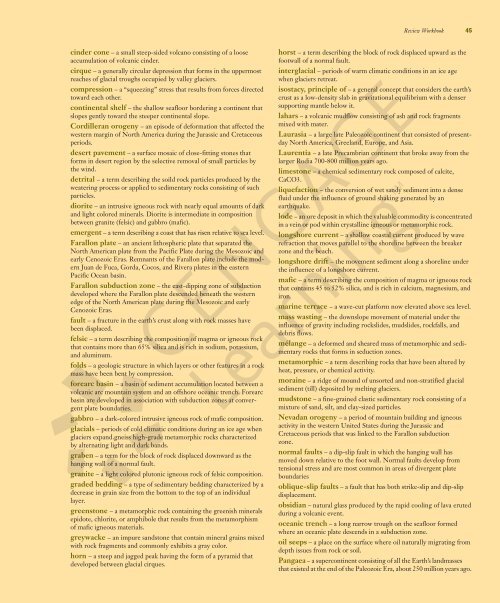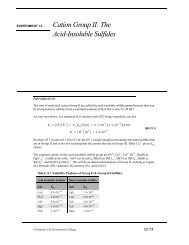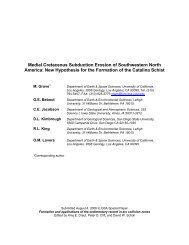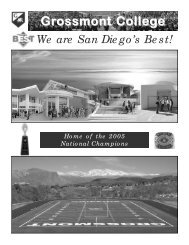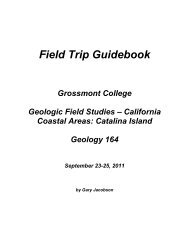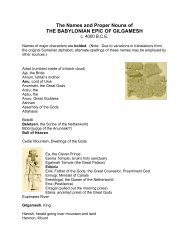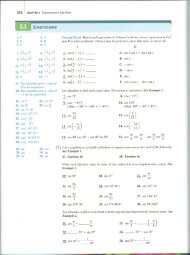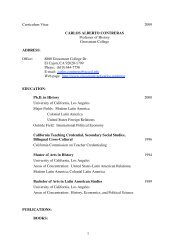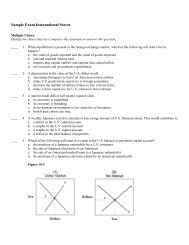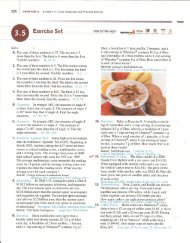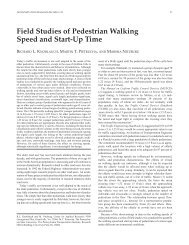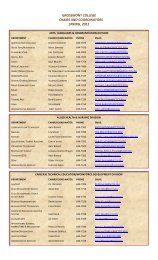Geology of Southern California.pdf - Grossmont College
Geology of Southern California.pdf - Grossmont College
Geology of Southern California.pdf - Grossmont College
Create successful ePaper yourself
Turn your PDF publications into a flip-book with our unique Google optimized e-Paper software.
cinder cone – a small steep-sided volcano consisting <strong>of</strong> a loose<br />
accumulation <strong>of</strong> volcanic cinder.<br />
cirque – a generally circular depression that forms in the uppermost<br />
reaches <strong>of</strong> glacial troughs occupied by valley glaciers.<br />
compression – a “squeezing” stress that results from forces directed<br />
toward each other.<br />
continental shelf – the shallow seafloor bordering a continent that<br />
slopes gently toward the steeper continental slope.<br />
Cordilleran orogeny – an episode <strong>of</strong> deformation that affected the<br />
western margin <strong>of</strong> North America during the Jurassic and Cretaceous<br />
periods.<br />
desert pavement – a surface mosaic <strong>of</strong> close-fitting stones that<br />
forms in desert region by the selective removal <strong>of</strong> small particles by<br />
the wind.<br />
detrital – a term describing the soild rock particles produced by the<br />
weatering process or applied to sedimentary rocks consisting <strong>of</strong> such<br />
particles.<br />
diorite – an intrusive igneous rock with nearly equal amounts <strong>of</strong> dark<br />
and light colored minerals. Diorite is intermediate in composition<br />
between granite (felsic) and gabbro (mafic).<br />
emergent – a term describing a coast that has risen relative to sea level.<br />
Farallon plate – an ancient lithospheric plate that separated the<br />
North American plate from the Pacific Plate during the Mesozoic and<br />
early Cenozoic Eras. Remnants <strong>of</strong> the Farallon plate include the modern<br />
Juan de Fuca, Gorda, Cocos, and Rivera plates in the eastern<br />
Pacific Ocean basin.<br />
Farallon subduction zone – the east-dipping zone <strong>of</strong> subduction<br />
developed where the Farallon plate descended beneath the western<br />
edge <strong>of</strong> the North American plate during the Mesozoic and early<br />
Cenozoic Eras.<br />
fault – a fracture in the earth’s crust along with rock masses have<br />
been displaced.<br />
felsic – a term describing the composition <strong>of</strong> magma or igneous rock<br />
that contains more than 65% silica and is rich in sodium, potassium,<br />
and aluminum.<br />
folds – a geologic structure in which layers or other features in a rock<br />
mass have been bent by compression.<br />
forearc basin – a basin <strong>of</strong> sediment accumulation located between a<br />
volcanic arc mountain system and an <strong>of</strong>fshore oceanic trench. Forearc<br />
basin are developed in association with subduction zones at convergent<br />
plate boundaries.<br />
gabbro – a dark-colored intrusive igneous rock <strong>of</strong> mafic composition.<br />
glacials – periods <strong>of</strong> cold climatic conditions during an ice age when<br />
glaciers expand.gneiss high-grade metamorphic rocks characterized<br />
by alternating light and dark bands.<br />
graben – a term for the block <strong>of</strong> rock displaced downward as the<br />
hanging wall <strong>of</strong> a normal fault.<br />
granite – a light colored plutonic igneous rock <strong>of</strong> felsic composition.<br />
graded bedding – a type <strong>of</strong> sedimentary bedding characterized by a<br />
decrease in grain size from the bottom to the top <strong>of</strong> an individual<br />
layer.<br />
greenstone – a metamorphic rock containing the greenish minerals<br />
epidote, chlorite, or amphibole that results from the metamorphism<br />
<strong>of</strong> mafic igneous materials.<br />
greywacke – an impure sandstone that contain mineral grains mixed<br />
with rock fragments and commonly exhibits a gray color.<br />
horn – a steep and jagged peak having the form <strong>of</strong> a pyramid that<br />
developed between glacial cirques.<br />
Review Workbook 45<br />
horst – a term describing the block <strong>of</strong> rock displaced upward as the<br />
footwall <strong>of</strong> a normal fault.<br />
interglacial – periods <strong>of</strong> warm climatic conditions in an ice age<br />
when glaciers retreat.<br />
isostacy, principle <strong>of</strong> – a general concept that considers the earth’s<br />
crust as a low-density slab in gravitational equilibrium with a denser<br />
supporting mantle below it.<br />
lahars – a volcanic mudflow consisting <strong>of</strong> ash and rock fragments<br />
mixed with mater.<br />
Laurasia – a large late Paleozoic continent that consisted <strong>of</strong> presentday<br />
North America, Greeland, Europe, and Asia.<br />
Laurentia – a late Precambrian continent that broke away from the<br />
larger Rodia 700-800 million years ago.<br />
limestone – a chemical sedimentary rock composed <strong>of</strong> calcite,<br />
CaCO3.<br />
liquefaction – the conversion <strong>of</strong> wet sandy sediment into a dense<br />
fluid under the influence <strong>of</strong> ground shaking generated by an<br />
earthquake.<br />
lode – an ore deposit in which the valuable commodity is concentrated<br />
in a vein or pod within crystalline igneous or metamorphic rock.<br />
longshore current – a shallow coastal current produced by wave<br />
refraction that moves parallel to the shoreline between the breaker<br />
zone and the beach.<br />
longshore drift – the movement sediment along a shoreline under<br />
the influence <strong>of</strong> a longshore current.<br />
mafic – a term describing the composition <strong>of</strong> magma or igneous rock<br />
that contains 45 to 52% silica, and is rich in calcium, magnesium, and<br />
iron.<br />
marine terrace – a wave-cut platform now elevated above sea level.<br />
mass wasting – the downslope movement <strong>of</strong> material under the<br />
influence <strong>of</strong> gravity including rockslides, mudslides, rockfalls, and<br />
debris flows.<br />
mélange – a deformed and sheared mass <strong>of</strong> metamorphic and sedimentary<br />
rocks that forms in seduction zones.<br />
metamorphic – a term describing rocks that have been altered by<br />
heat, pressure, or chemical activity.<br />
moraine – a ridge <strong>of</strong> mound <strong>of</strong> unsorted and non-stratified glacial<br />
sediment (till) deposited by melting glaciers.<br />
mudstone – a fine-grained clastic sedimentary rock consisting <strong>of</strong> a<br />
mixture <strong>of</strong> sand, silt, and clay-sized particles.<br />
Nevadan orogeny – a period <strong>of</strong> mountain building and igneous<br />
activity in the western United States during the Jurassic and<br />
Cretaceous periods that was linked to the Farallon subduction<br />
zone.<br />
normal faults – a dip-slip fault in which the hanging wall has<br />
moved down relative to the foot wall. Normal faults develop from<br />
tensional stress and are most common in areas <strong>of</strong> divergent plate<br />
boundaries<br />
oblique-slip faults – a fault that has both strike-slip and dip-slip<br />
displacement.<br />
obsidian – natural glass produced by the rapid cooling <strong>of</strong> lava eruted<br />
during a volcanic event.<br />
oceanic trench – a long narrow trough on the seafloor formed<br />
where an oceanic plate descends in a subduction zone.<br />
oil seeps – a place on the surface where oil naturally migrating from<br />
depth issues from rock or soil.<br />
Pangaea – a supercontinent consisting <strong>of</strong> all the Earth’s landmasses<br />
that existed at the end <strong>of</strong> the Paleozoic Era, about 250 million years ago.


